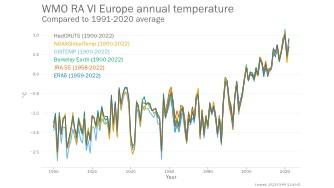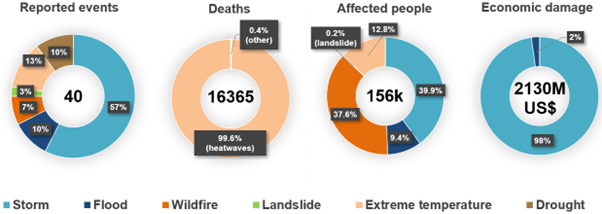Climate change impacts scar Europe, but increase in renewables signals hope for future
Climate change is taking a major human, economic and environmental toll in Europe, the fastest warming continent of the world. The year 2022 was marked by extreme heat, drought and wildfires. Sea surface temperatures around Europe reached new highs, accompanied by marine heatwaves. Glacier melt was unprecedented.

The State of the Climate in Europe 2022 report, the second in an annual series, was produced jointly by the World Meteorological Organization and the European Union’s Copernicus Climate Change Service.
It shows how Europe has been warming twice as much as the global average since the 1980s, with far-reaching impacts on the region’s socio-economic fabric and ecosystems. In 2022, Europe was approximately 2.3 °C above the pre-industrial (1850-1900) average used as a baseline for the Paris Agreement on climate change.
But, in a sign of hope for the future, renewable energy generated more electricity than polluting fossil gas for the first time last year. Wind and solar power generated 22.3% of European Union (EU) electricity in 2022, overtaking fossil gas (20%).
“For the first time, more electricity was generated by wind and solar than by fossil gas in the EU. Increasing use of renewables and low-carbon energy sources is crucial to reduce dependence on fossil fuels,” said WMO Secretary-General Prof. Petteri Taalas. “Climate services play a key role in ensuring the resilience of energy systems to climate-related shocks, in planning operations, and in informing measures to increase energy efficiency,” he said.
The report has a special focus on energy and highlights how more extreme weather, including intense heat, heavy precipitation and droughts have growing implications for the supply, demand and infrastructure of Europe’s energy system.


The report was released to coincide with the 6th European Climate Change Adaptation Conference in Dublin, Ireland, and is accompanied by an interactive Story Map.
“The record-breaking heat stress that Europeans experienced in 2022 was one of the main drivers of weather-related excess deaths in Europe. Unfortunately, this cannot be considered a one-off occurrence or an oddity of the climate. Our current understanding of the climate system and its evolution informs us that these kinds of events are part of a pattern that will make heat stress extremes more frequent and more intense across the region,” said Dr Carlo Buontempo, Director, Copernicus Climate Change Service.
Based on information in the Emergency Events Database (EM-DAT), meteorological, hydrological and climate-related hazards in Europe in 2022 resulted in 16 365 reported fatalities and directly affected 156 000 people.
About 67% of the events were flood- and storm-related, accounting for most of the total economic damages of about US$ 2 billion. Much more severe, in terms of mortality, were the heatwaves, which reportedly led to more than 16000 excess deaths.
“In 2022, many countries in western and south-western Europe had their warmest year on record. Summer was the hottest ever recorded: the high temperatures exacerbated the severe and widespread drought conditions, fuelled violent wildfires that resulted in the second largest burnt area on record, and led to thousands of heat-associated excess deaths,” said Prof. Taalas.

Note: Impact numbers for some disaster occurrences may be lacking due to data unavailability.










